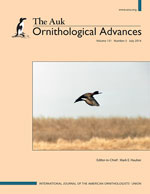The decision to breed influences an individual's current and future reproduction, and the proportion of individuals that breed is an important determinant of population dynamics. Age, experience, individual quality, and environmental conditions have all been demonstrated to influence breeding propensity. To elucidate which of these factors exerts the greatest influence on breeding propensity in a temperate waterfowl, we studied female Lesser Scaup (Aythya affinis) breeding in southwestern Montana. Females were captured during the breeding seasons of 2007–2009, and breeding status was determined on the basis of (1) presence of an egg in the oviduct or (2) blood plasma vitellogenin (VTG) levels. Presence on the study site in the previous year, a proxy for adult female success, was determined with stable isotope signatures of a primary feather collected at capture. Overall, 57% of females had evidence of breeding at the time of capture; this increased to 86% for females captured on or after peak nest initiation. Capture date and size-adjusted body condition positively influenced breeding propensity, with a declining body-condition threshold through the breeding season. We did not detect an influence of age on breeding propensity. Drought conditions negatively affected breeding propensity, reducing the proportion of breeding females to 0.85 (SE = 0.05) from 0.94 (SE = 0.03) during normal-water years. A female that was present in the previous breeding season was 5% more likely to breed than a female that was not present then. The positive correlation between age and experience makes it difficult to differentiate the roles of age, experience, and individual quality in reproductive success in vertebrates. Our results indicate that individual quality, as expressed by previous success and current body condition, may be among the most important determinants of breeding propensity in female Lesser Scaup, providing further support for the individual heterogeneity hypothesis.
How to translate text using browser tools
7 May 2014
Previous success and current body condition determine breeding propensity in Lesser Scaup: evidence for the individual heterogeneity hypothesis
Jeffrey M. Warren,
Kyle A. Cutting,
John Y. Takekawa,
Susan E. De La Cruz,
Tony D. Williams,
David N. Koons
ACCESS THE FULL ARTICLE

The Auk
Vol. 131 • No. 3
July 2014
Vol. 131 • No. 3
July 2014
age
Aythya affinis
Breeding probability
Montana
waterfowl




